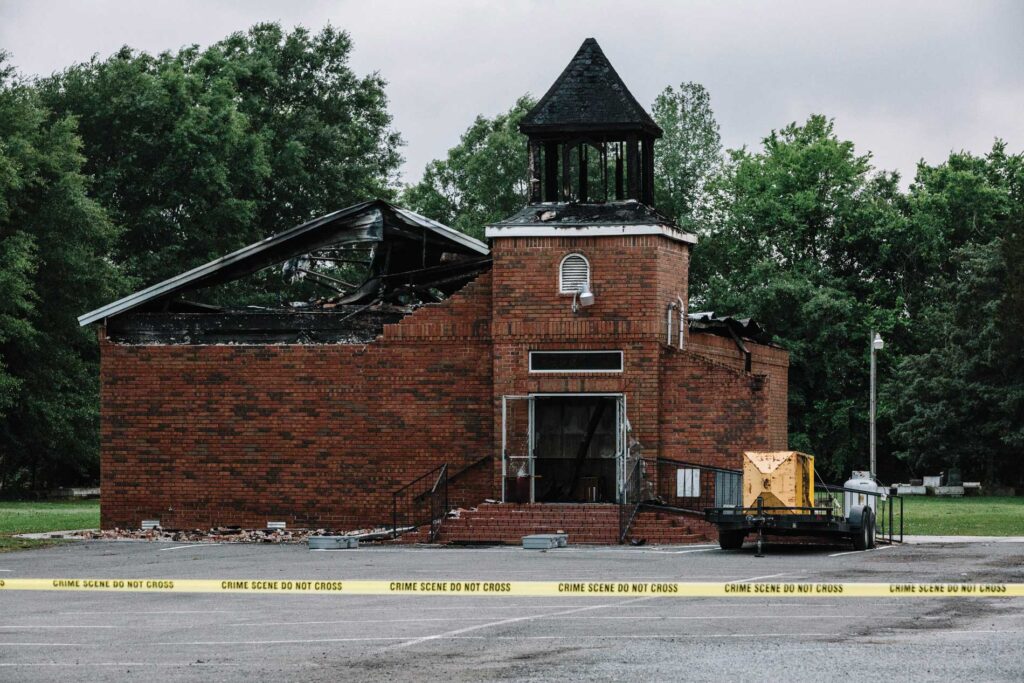Racial Terror Massacre
Opelousas, Louisiana

Mount Pleasant Baptist Church in Opelousas, Louisiana, was burned in a suspected arson in April 2019—the third Black church burned in St. Landry Parish in 10 days.
William Widmer/ The New York Times/Redux
In states throughout the South, elections triggered mass violence that indiscriminately terrorized Black communities, killing dozens or hundreds and sending a clear message to many more that political activity would result in death.
In the fall of 1868, the town of Opelousas was the site of Louisiana’s deadliest Reconstruction-era massacre.1 Lorraine Boissoneault, “The Deadliest Massacre in Reconstruction-Era Louisiana Happened 150 Years Ago,” Smithsonian Magazine, September 28, 2018. Over the course of about two weeks, white citizens terrorized African Americans to suppress Black voter turnout in the upcoming election, killing an estimated 200 people and devastating the local community.
Louisiana’s Reconstruction government had adopted a new state constitution that April. In compliance with the Fifteenth Amendment, it declared that Black men were entitled to vote and guaranteed Black children access to education.2 Title VI, Art. 99 La. Const. (1868); Title VII, Art. 135 La. Const. (1868). Former Confederates seeking to regain power and restore white supremacy in the state opposed these provisions. They also resented the federal officials and white Northerners present in Louisiana to enforce Black civil rights. The desire to keep Black people oppressed after Emancipation was especially strong in Opelousas, the seat of St. Landry Parish. Though the parish was home to just 14,000 people, an estimated 3,000 white male residents were members of the Seymour Knights—a branch of the white supremacist Knights of the White Camelia, which was similar to the Ku Klux Klan.3 Christopher Long, “Knights of the White Camellia,”
Texas State Historical Association, May 1, 2019.
Soon after the Civil War’s end, a local city ordinance announced: “No Negro or freedman shall be allowed to come within the limits of the town of Opelousas without special permission from his employer, specifying the object of his visit and the time necessary for the accomplishment of the same.”4 Du Bois, Black Reconstruction, 177.
White residents of Opelousas grew increasingly resentful of Black voting rights as the 1868 election approached. On September 28, a group of local white men threatened and then severely beat Emerson Bently, a white man who’d written an article that exposed local voter intimidation. Mr. Bently had moved to Louisiana from Ohio to teach with the local Freedmen’s Bureau. Also a voting rights advocate and newspaper editor, he was a rare white ally of Black voters in St. Landry Parish and had been threatened repeatedly before the attack.5 Boissoneault, “The Deadliest Massacre in Reconstruction-Era Louisiana Happened 150 Years Ago”; Carl A. Brasseaux, Keith P. Fontenot & Claude F. Oubre, Creoles of Color in the Bayou Country (Jackson: University Press of Mississippi, 1994), 101.
After hearing about the attack on Mr. Bently, Black men in the community armed themselves for protection and 27 were soon arrested or killed by white mobs. Over the next two weeks, armed white men patrolled Opelousas and surrounding communities, terrorizing and killing Black residents indiscriminately. By some estimates, the violence killed at least 30 white people—including some who were targeted by mobs for being sympathetic to Black rights—and left an estimated 200 Black people dead.6 Carolyn E. DeLatte, “The St. Landry Riot: A Forgotten Incident of Reconstruction Violence,” J. La. Hist. Assoc. (Vol. 17: Winter 1976), 41-49; New Orleans Republican, “The St. Landry Massacre,” October 12, 1868.
Press accounts of the violence were skewed because white mobs destroyed the printing presses used by progressive publications and killed a white man who worked as an editor of the pro-Reconstruction St. Landry Progress newspaper. White supremacist newspapers dominated post-massacre reporting and flooded the press with inaccurate tales of a “race riot.” It would be eight years before another progressive newspaper was launched in the parish.7 Boissoneault, “The Deadliest Massacre in Reconstruction-Era Louisiana Happened 150 Years Ago.”
Weeks after the massacre, a Franklin, Louisiana, newspaper victoriously declared, “The negroes in St. Landry are, for the first time since the war, polite and well disposed, and work well.”8 New Orleans Republican, “The St. Landry Massacre,” October 12, 1868, reprinting editorials from The Franklin Banner, October 10, 1868.
Our white people deeply regret the necessity which compelled the citizens of St. Landry to kill and cripple so many negroes in the late Opelousas riot, but the negroes for more than a year have laughed at the warnings and advice given them by the planters and citizens of that parish . . . a fight was inevitable. It was the last and only effectual argument that could be used with the negro . . . A carpet-bag editor and his miserable, incendiary sheet caused the riot. The editor escaped, and a hundred dead negroes, and perhaps a hundred more wounded and crippled . . . are the upshot of the business.9 Ibid.
The brutal attacks in Opelousas terrorized Black voters into silence. Former Union General Ulysses S. Grant won the 1868 presidential election without a single vote from St. Landry Parish. Recounting this “remarkable case,” W.E.B. Du Bois later observed: “Here occurred one of the bloodiest riots on record, in which the Ku Klux killed and wounded over 200 Republicans, hunting and chasing them for two days and nights through fields and swamps . . . [P]rior to the Presidential election in November, 1868, half the state was overrun by violence, and midnight raids, secret murders, and open riot kept the people in constant terror.”10 Du Bois, Black Reconstruction, 681.